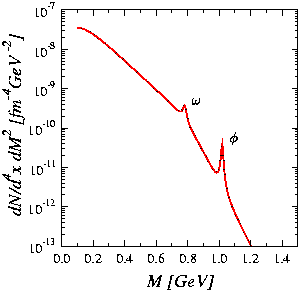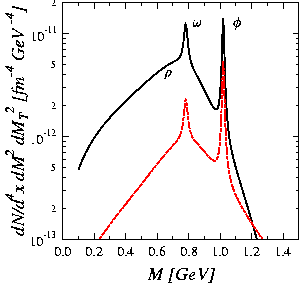|
The starting experimental programme at the new detector facility HADES
at SIS/GSI Darmstadt offers the access to dileptons in various
reactions of heavy ions and hadrons (pions and protons) with various
nuclear targets. One motivation of such experiments is the study of
the
in-medium change of the vector meson spectral functions.
Within various models vastly different predictions are available
ranging from a simple shift of the pole position of the spectral
function to a strong broadening up to a fragmentation due to
particle-hole excitations caused by the ambient matter.
While a moderate broadening of the most sensitive r meson
spectral function leads probably to a disappearance
of the r peak in the invariant
mass spectrum d s/ dM2,
we have shown in [1] that, within a schematic blast
wave model, measuring the double differential cross section
d s/ dM2 dM^2 in a sufficiently restricted interval
of the transverse mass M^ as function of the invariant mass
M still allows to identify the r signal.
As an example, in Fig. 1 the dilepton emission rate is displayed.
Here, we assumed that the widths of the vector mesons are increased
by a factor of 3 due to in-medium effects. Indeed, while
in the invariant mass spectrum the r peak is not longer
visible, selecting an narrow interval of values of M^ the
r is clearly seen.
This feature is persistent when integrating the rate over the
space-time history of the radiating matter. Additional complications
arise due to the suspected strong coupling of the widths and pole
positions to the baryon density and temperature,
which change in space and time.
Employing a transport calculation of BUU type we have checked
that such background contributions as pn bremsstrahlung,
h Dalitz and D Dalitz decays are sufficiently
strongly suppressed when selecting the interval
850 MeV < M^ < 950 MeV. The count rates for this
range of M^ are not too small to make such
measurements feasible.
Fig. 1
The dilepton emission rates dN/(d4 x dM2) (left panel) and
dN/(d4 x dM^2 dM2) (right panel, M^ = 1.3 GeV)
for T = 70 MeV and radial expansion velocities of
vr = 0.1 (dashed curve) and 0.3 (solid curve).
1Institute of Theoretical Physics, Kiev, Ukraine
2KFKI Budapest, Hungary
References
[1]
B. Kämpfer, O.P. Pavlenko, Eur. Phys. J. A 10, 101 (2001)
IKH
06/19/01
© B. Kämpfer
|

